CHEVROLET EXPRESS CARGO VAN 2004 1.G Repair Manual
Manufacturer: CHEVROLET, Model Year: 2004, Model line: EXPRESS CARGO VAN, Model: CHEVROLET EXPRESS CARGO VAN 2004 1.GPages: 406, PDF Size: 2.66 MB
Page 61 of 406
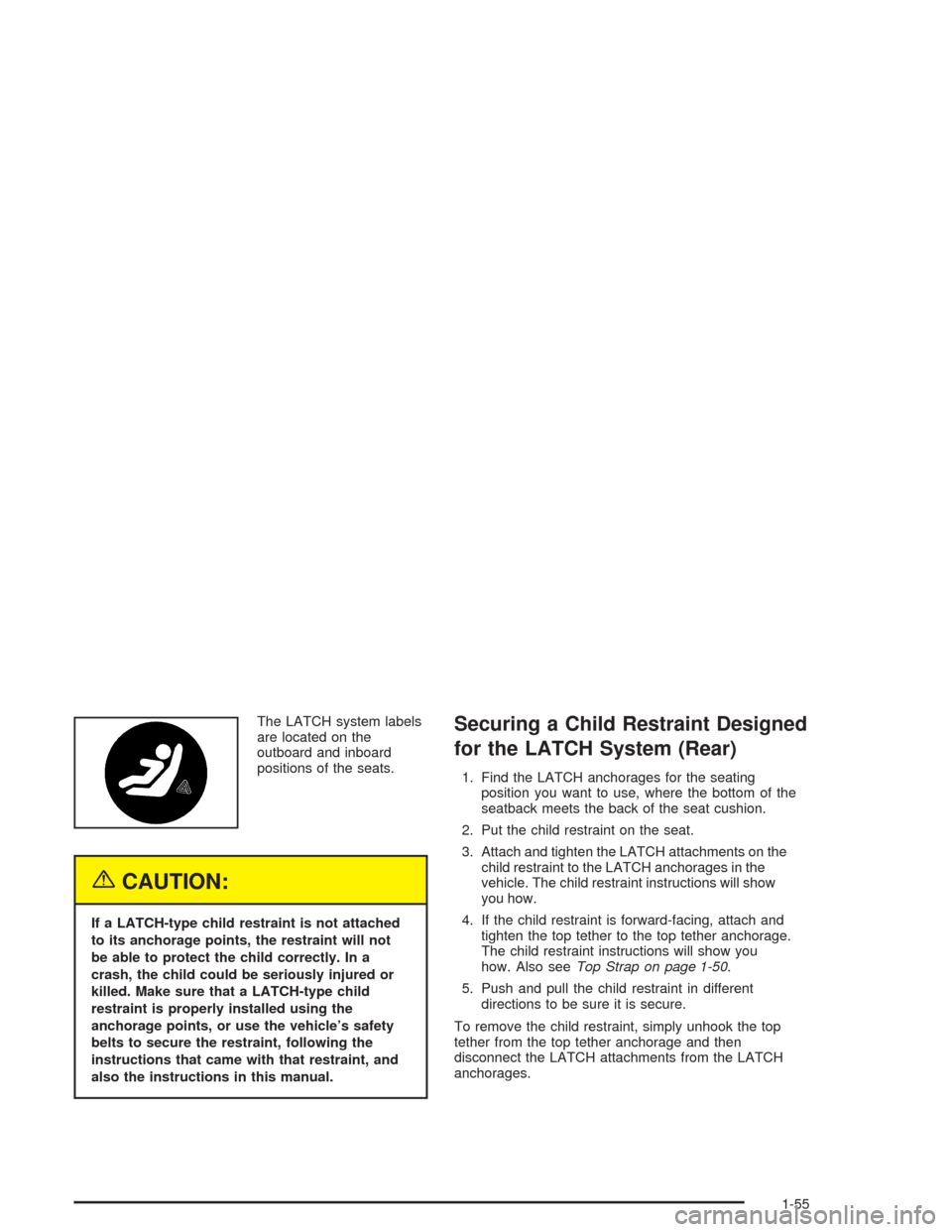
The LATCH system labels
are located on the
outboard and inboard
positions of the seats.
{CAUTION:
If a LATCH-type child restraint is not attached
to its anchorage points, the restraint will not
be able to protect the child correctly. In a
crash, the child could be seriously injured or
killed. Make sure that a LATCH-type child
restraint is properly installed using the
anchorage points, or use the vehicle’s safety
belts to secure the restraint, following the
instructions that came with that restraint, and
also the instructions in this manual.
Securing a Child Restraint Designed
for the LATCH System (Rear)
1. Find the LATCH anchorages for the seating
position you want to use, where the bottom of the
seatback meets the back of the seat cushion.
2. Put the child restraint on the seat.
3. Attach and tighten the LATCH attachments on the
child restraint to the LATCH anchorages in the
vehicle. The child restraint instructions will show
you how.
4. If the child restraint is forward-facing, attach and
tighten the top tether to the top tether anchorage.
The child restraint instructions will show you
how. Also seeTop Strap on page 1-50.
5. Push and pull the child restraint in different
directions to be sure it is secure.
To remove the child restraint, simply unhook the top
tether from the top tether anchorage and then
disconnect the LATCH attachments from the LATCH
anchorages.
1-55
Page 62 of 406
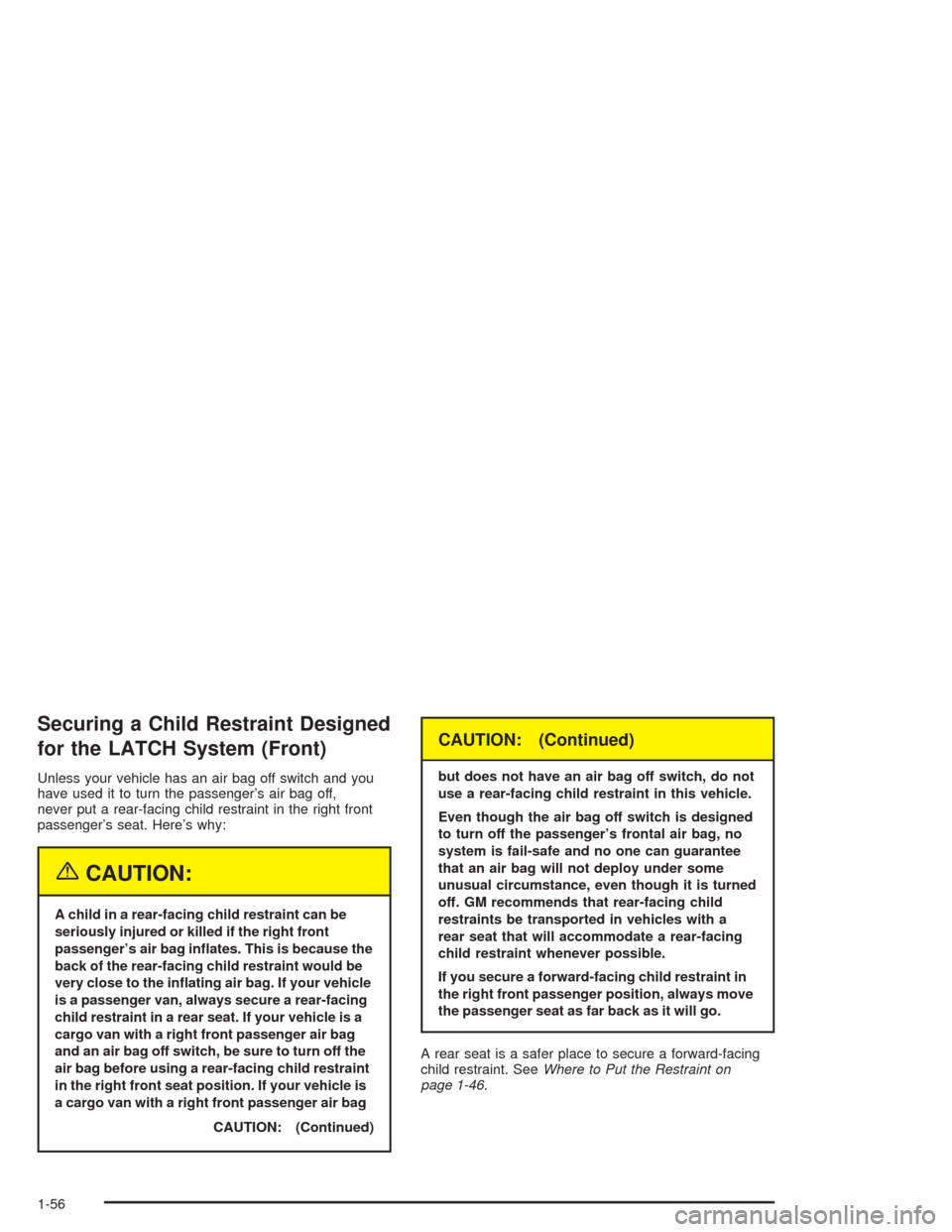
Securing a Child Restraint Designed
for the LATCH System (Front)
Unless your vehicle has an air bag off switch and you
have used it to turn the passenger’s air bag off,
never put a rear-facing child restraint in the right front
passenger’s seat. Here’s why:
{CAUTION:
A child in a rear-facing child restraint can be
seriously injured or killed if the right front
passenger’s air bag in�ates. This is because the
back of the rear-facing child restraint would be
very close to the in�ating air bag. If your vehicle
is a passenger van, always secure a rear-facing
child restraint in a rear seat. If your vehicle is a
cargo van with a right front passenger air bag
and an air bag off switch, be sure to turn off the
air bag before using a rear-facing child restraint
in the right front seat position. If your vehicle is
a cargo van with a right front passenger air bag
CAUTION: (Continued)
CAUTION: (Continued)
but does not have an air bag off switch, do not
use a rear-facing child restraint in this vehicle.
Even though the air bag off switch is designed
to turn off the passenger’s frontal air bag, no
system is fail-safe and no one can guarantee
that an air bag will not deploy under some
unusual circumstance, even though it is turned
off. GM recommends that rear-facing child
restraints be transported in vehicles with a
rear seat that will accommodate a rear-facing
child restraint whenever possible.
If you secure a forward-facing child restraint in
the right front passenger position, always move
the passenger seat as far back as it will go.
A rear seat is a safer place to secure a forward-facing
child restraint. SeeWhere to Put the Restraint on
page 1-46.
1-56
Page 63 of 406
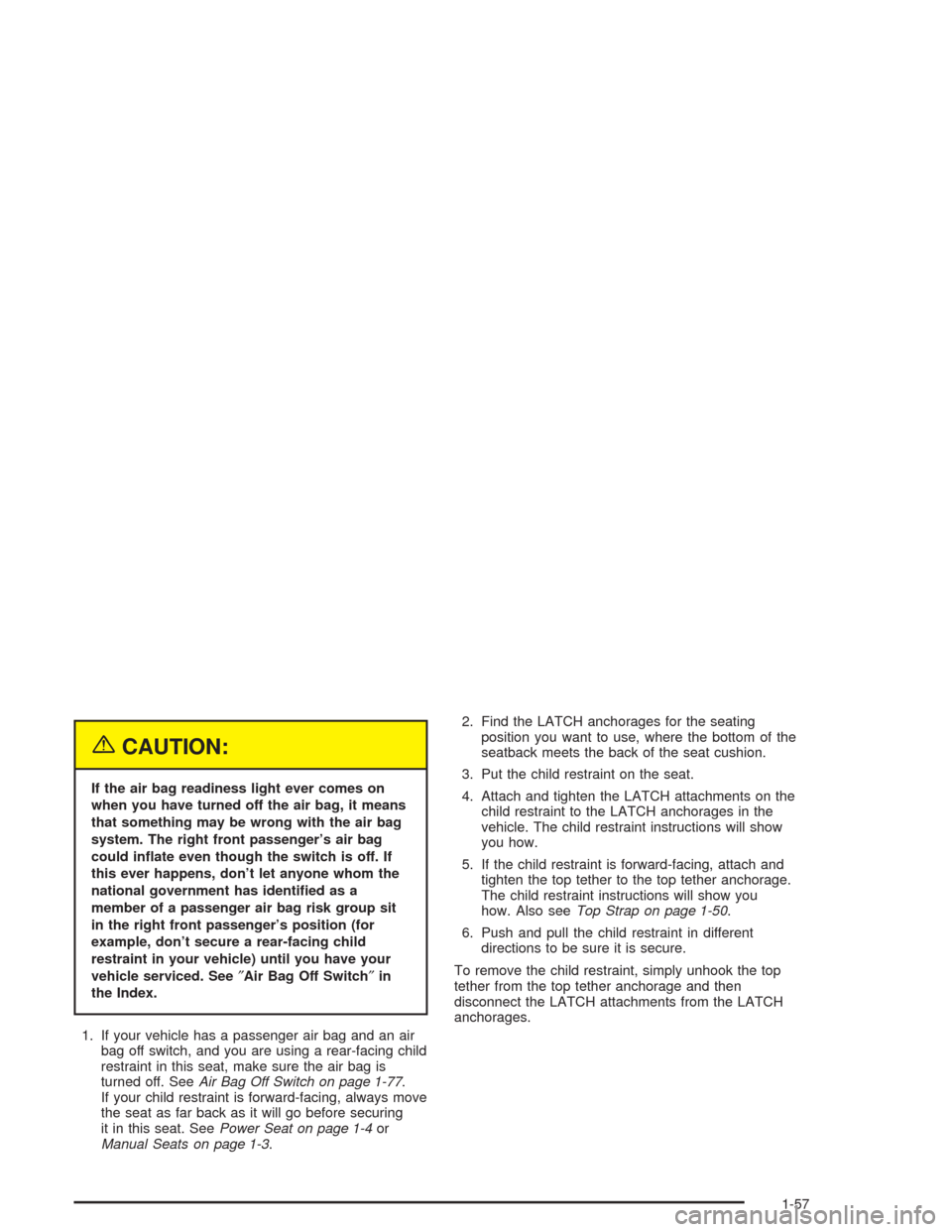
{CAUTION:
If the air bag readiness light ever comes on
when you have turned off the air bag, it means
that something may be wrong with the air bag
system. The right front passenger’s air bag
could in�ate even though the switch is off. If
this ever happens, don’t let anyone whom the
national government has identi�ed as a
member of a passenger air bag risk group sit
in the right front passenger’s position (for
example, don’t secure a rear-facing child
restraint in your vehicle) until you have your
vehicle serviced. See″Air Bag Off Switch″in
the Index.
1. If your vehicle has a passenger air bag and an air
bag off switch, and you are using a rear-facing child
restraint in this seat, make sure the air bag is
turned off. SeeAir Bag Off Switch on page 1-77.
If your child restraint is forward-facing, always move
the seat as far back as it will go before securing
it in this seat. SeePower Seat on page 1-4or
Manual Seats on page 1-3.2. Find the LATCH anchorages for the seating
position you want to use, where the bottom of the
seatback meets the back of the seat cushion.
3. Put the child restraint on the seat.
4. Attach and tighten the LATCH attachments on the
child restraint to the LATCH anchorages in the
vehicle. The child restraint instructions will show
you how.
5. If the child restraint is forward-facing, attach and
tighten the top tether to the top tether anchorage.
The child restraint instructions will show you
how. Also seeTop Strap on page 1-50.
6. Push and pull the child restraint in different
directions to be sure it is secure.
To remove the child restraint, simply unhook the top
tether from the top tether anchorage and then
disconnect the LATCH attachments from the LATCH
anchorages.
1-57
Page 64 of 406
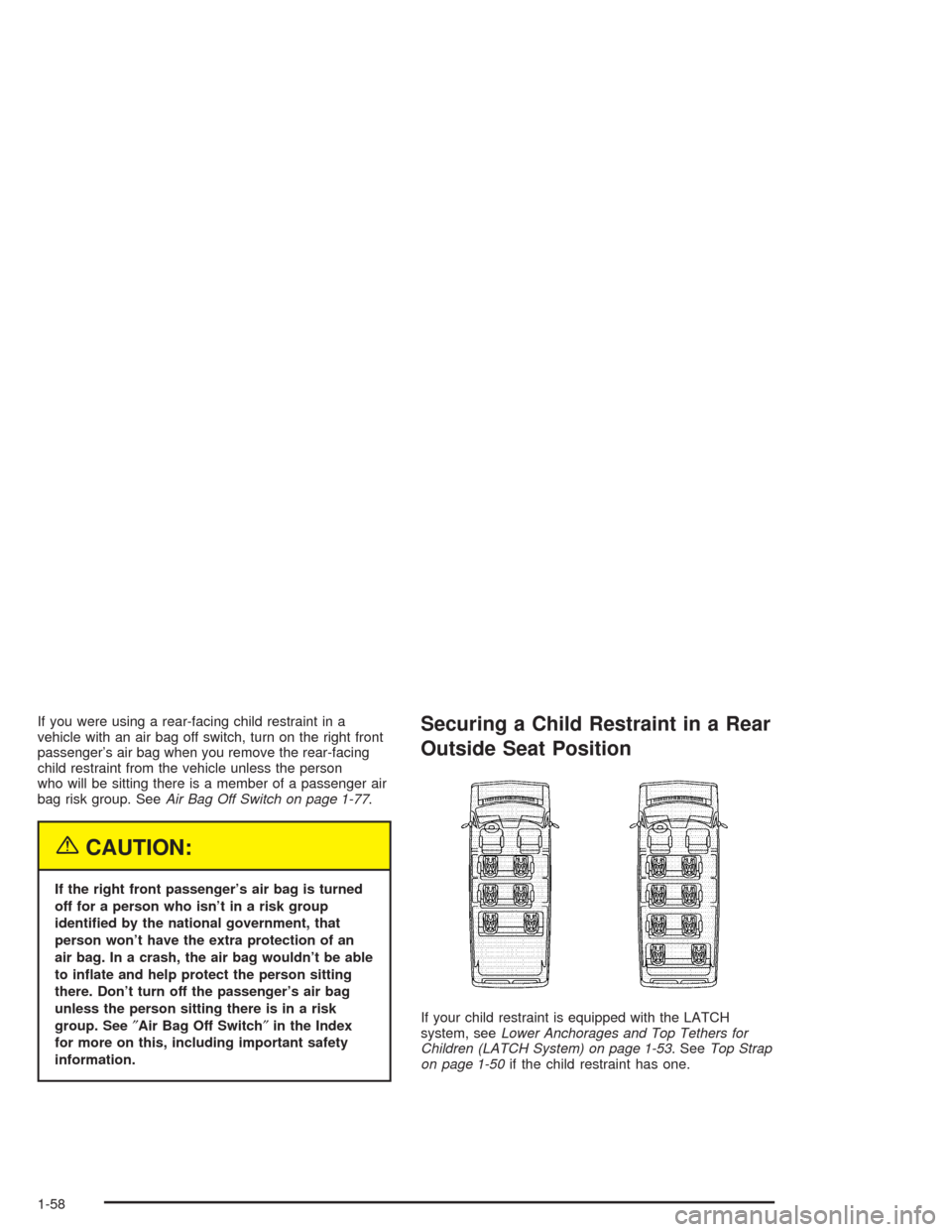
If you were using a rear-facing child restraint in a
vehicle with an air bag off switch, turn on the right front
passenger’s air bag when you remove the rear-facing
child restraint from the vehicle unless the person
who will be sitting there is a member of a passenger air
bag risk group. SeeAir Bag Off Switch on page 1-77.
{CAUTION:
If the right front passenger’s air bag is turned
off for a person who isn’t in a risk group
identi�ed by the national government, that
person won’t have the extra protection of an
air bag. In a crash, the air bag wouldn’t be able
to in�ate and help protect the person sitting
there. Don’t turn off the passenger’s air bag
unless the person sitting there is in a risk
group. See″Air Bag Off Switch″in the Index
for more on this, including important safety
information.
Securing a Child Restraint in a Rear
Outside Seat Position
If your child restraint is equipped with the LATCH
system, seeLower Anchorages and Top Tethers for
Children (LATCH System) on page 1-53. SeeTop Strap
on page 1-50if the child restraint has one.
1-58
Page 65 of 406
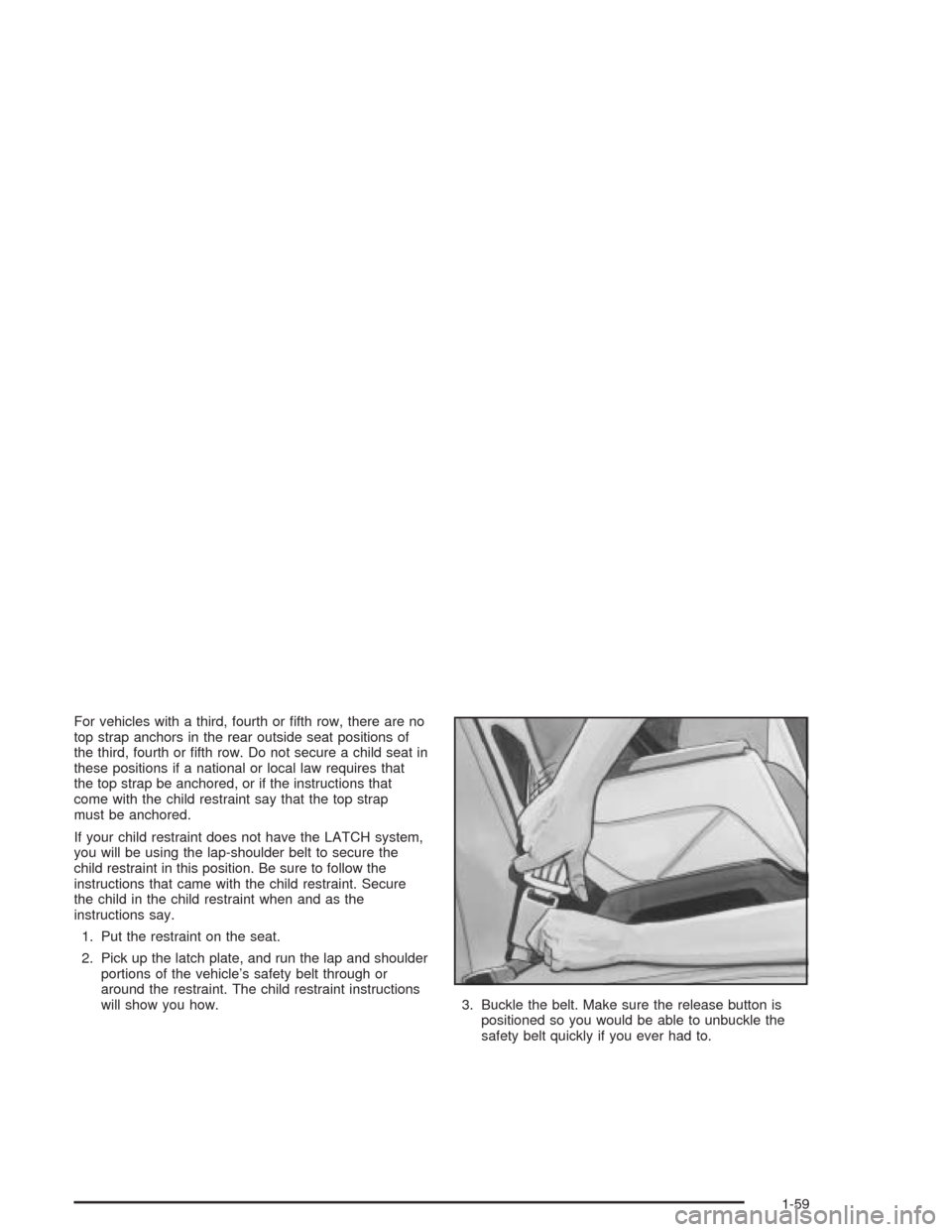
For vehicles with a third, fourth or �fth row, there are no
top strap anchors in the rear outside seat positions of
the third, fourth or �fth row. Do not secure a child seat in
these positions if a national or local law requires that
the top strap be anchored, or if the instructions that
come with the child restraint say that the top strap
must be anchored.
If your child restraint does not have the LATCH system,
you will be using the lap-shoulder belt to secure the
child restraint in this position. Be sure to follow the
instructions that came with the child restraint. Secure
the child in the child restraint when and as the
instructions say.
1. Put the restraint on the seat.
2. Pick up the latch plate, and run the lap and shoulder
portions of the vehicle’s safety belt through or
around the restraint. The child restraint instructions
will show you how.3. Buckle the belt. Make sure the release button is
positioned so you would be able to unbuckle the
safety belt quickly if you ever had to.
1-59
Page 66 of 406
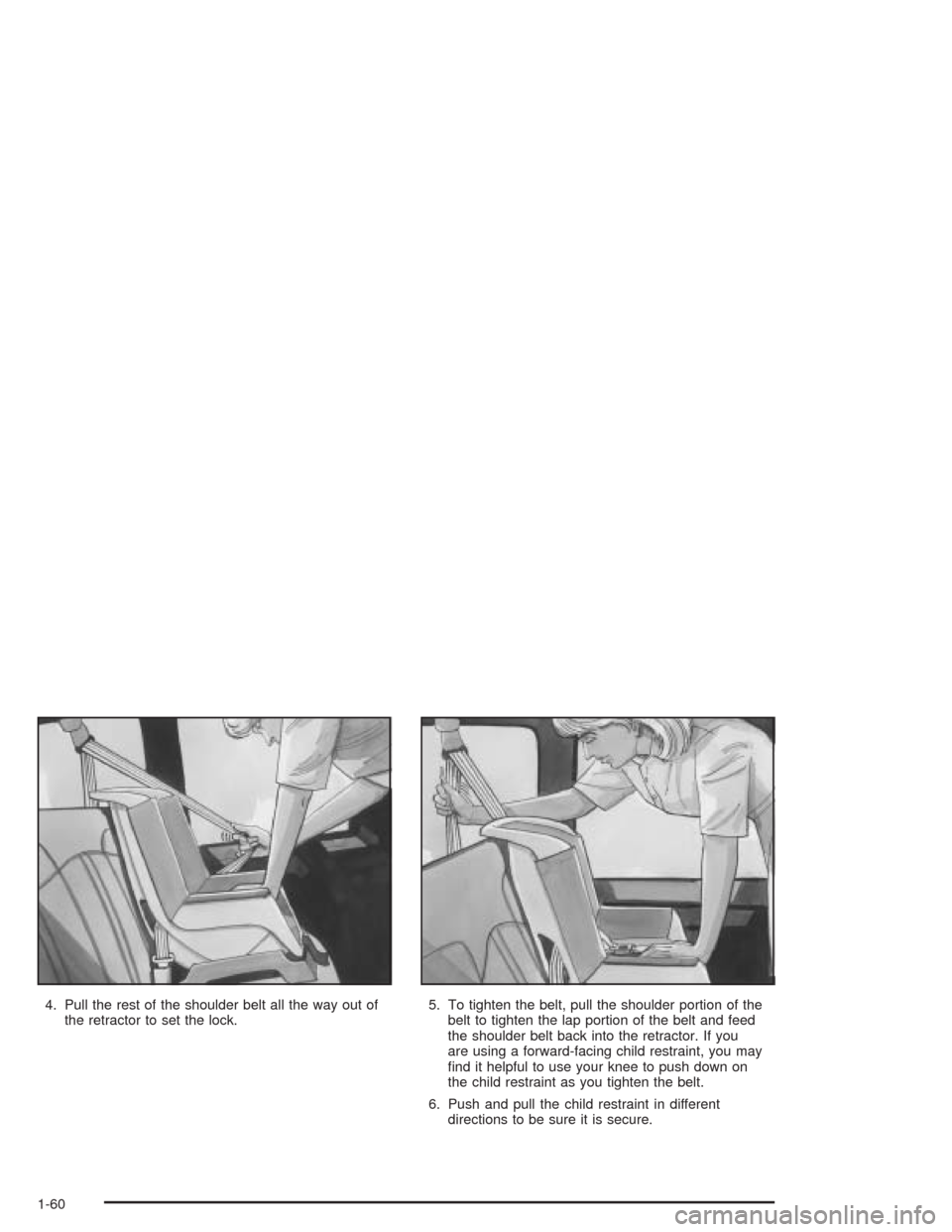
4. Pull the rest of the shoulder belt all the way out of
the retractor to set the lock.5. To tighten the belt, pull the shoulder portion of the
belt to tighten the lap portion of the belt and feed
the shoulder belt back into the retractor. If you
are using a forward-facing child restraint, you may
�nd it helpful to use your knee to push down on
the child restraint as you tighten the belt.
6. Push and pull the child restraint in different
directions to be sure it is secure.
1-60
Page 67 of 406
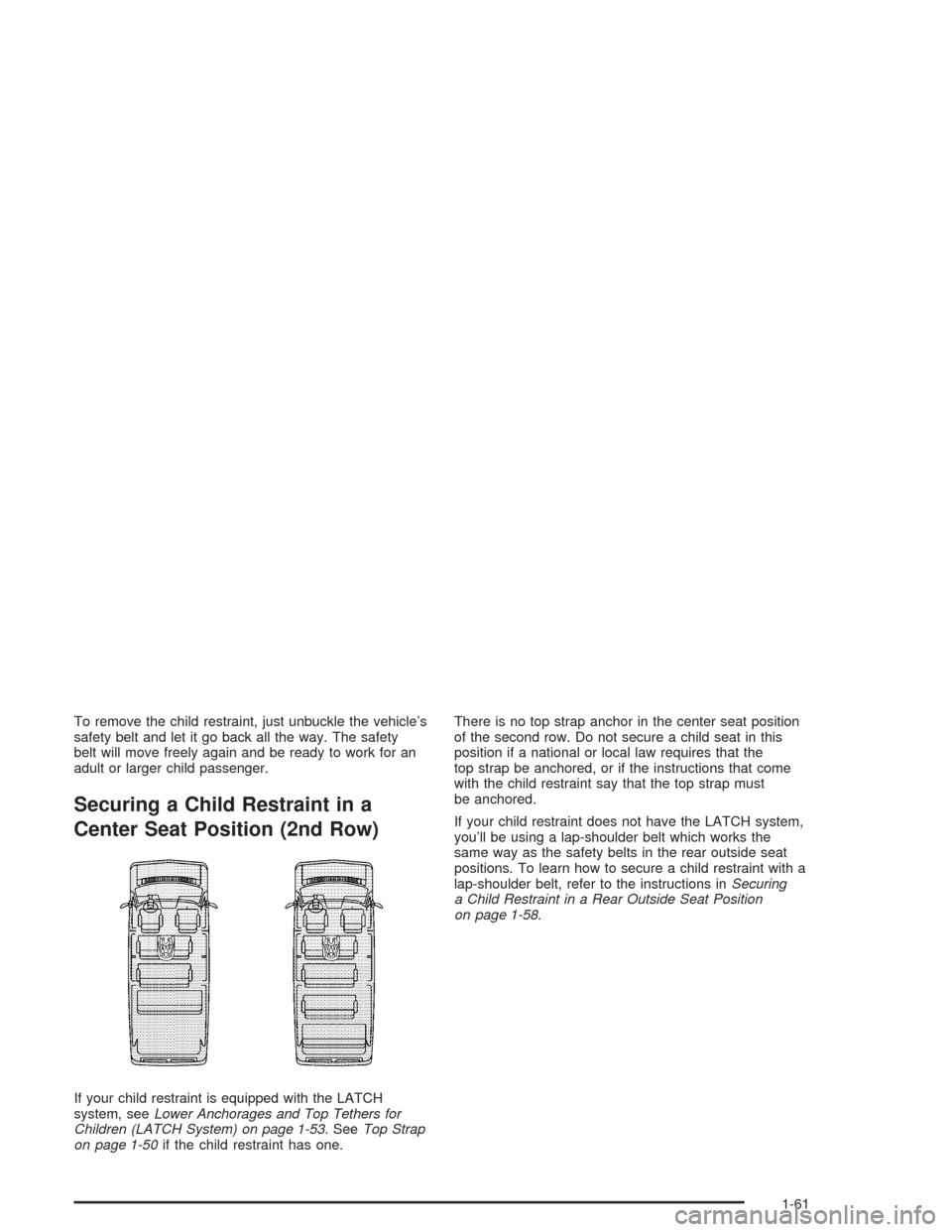
To remove the child restraint, just unbuckle the vehicle’s
safety belt and let it go back all the way. The safety
belt will move freely again and be ready to work for an
adult or larger child passenger.
Securing a Child Restraint in a
Center Seat Position (2nd Row)
If your child restraint is equipped with the LATCH
system, seeLower Anchorages and Top Tethers for
Children (LATCH System) on page 1-53. SeeTop Strap
on page 1-50if the child restraint has one.There is no top strap anchor in the center seat position
of the second row. Do not secure a child seat in this
position if a national or local law requires that the
top strap be anchored, or if the instructions that come
with the child restraint say that the top strap must
be anchored.
If your child restraint does not have the LATCH system,
you’ll be using a lap-shoulder belt which works the
same way as the safety belts in the rear outside seat
positions. To learn how to secure a child restraint with a
lap-shoulder belt, refer to the instructions inSecuring
a Child Restraint in a Rear Outside Seat Position
on page 1-58.
1-61
Page 68 of 406
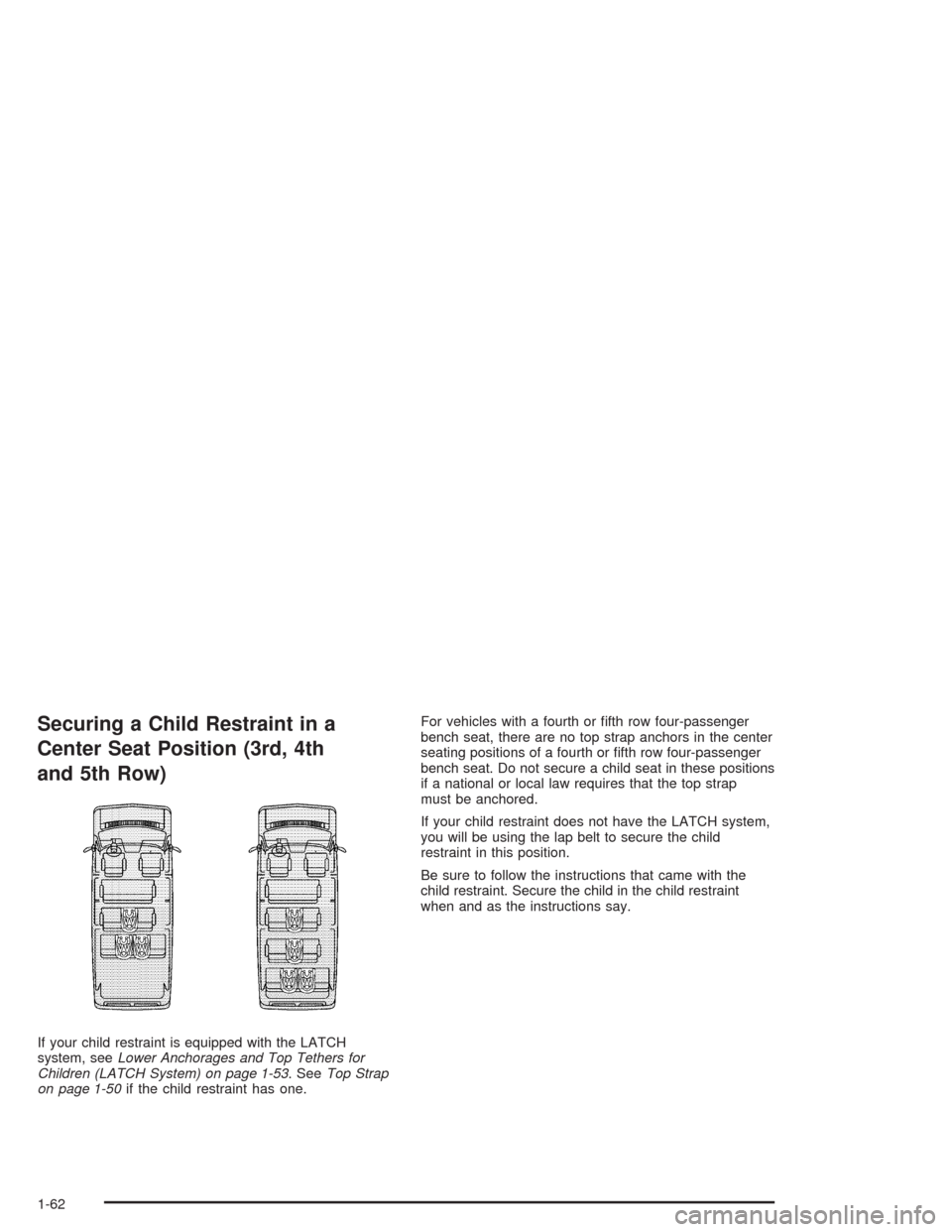
Securing a Child Restraint in a
Center Seat Position (3rd, 4th
and 5th Row)
If your child restraint is equipped with the LATCH
system, seeLower Anchorages and Top Tethers for
Children (LATCH System) on page 1-53. SeeTop Strap
on page 1-50if the child restraint has one.For vehicles with a fourth or �fth row four-passenger
bench seat, there are no top strap anchors in the center
seating positions of a fourth or �fth row four-passenger
bench seat. Do not secure a child seat in these positions
if a national or local law requires that the top strap
must be anchored.
If your child restraint does not have the LATCH system,
you will be using the lap belt to secure the child
restraint in this position.
Be sure to follow the instructions that came with the
child restraint. Secure the child in the child restraint
when and as the instructions say.
1-62
Page 69 of 406
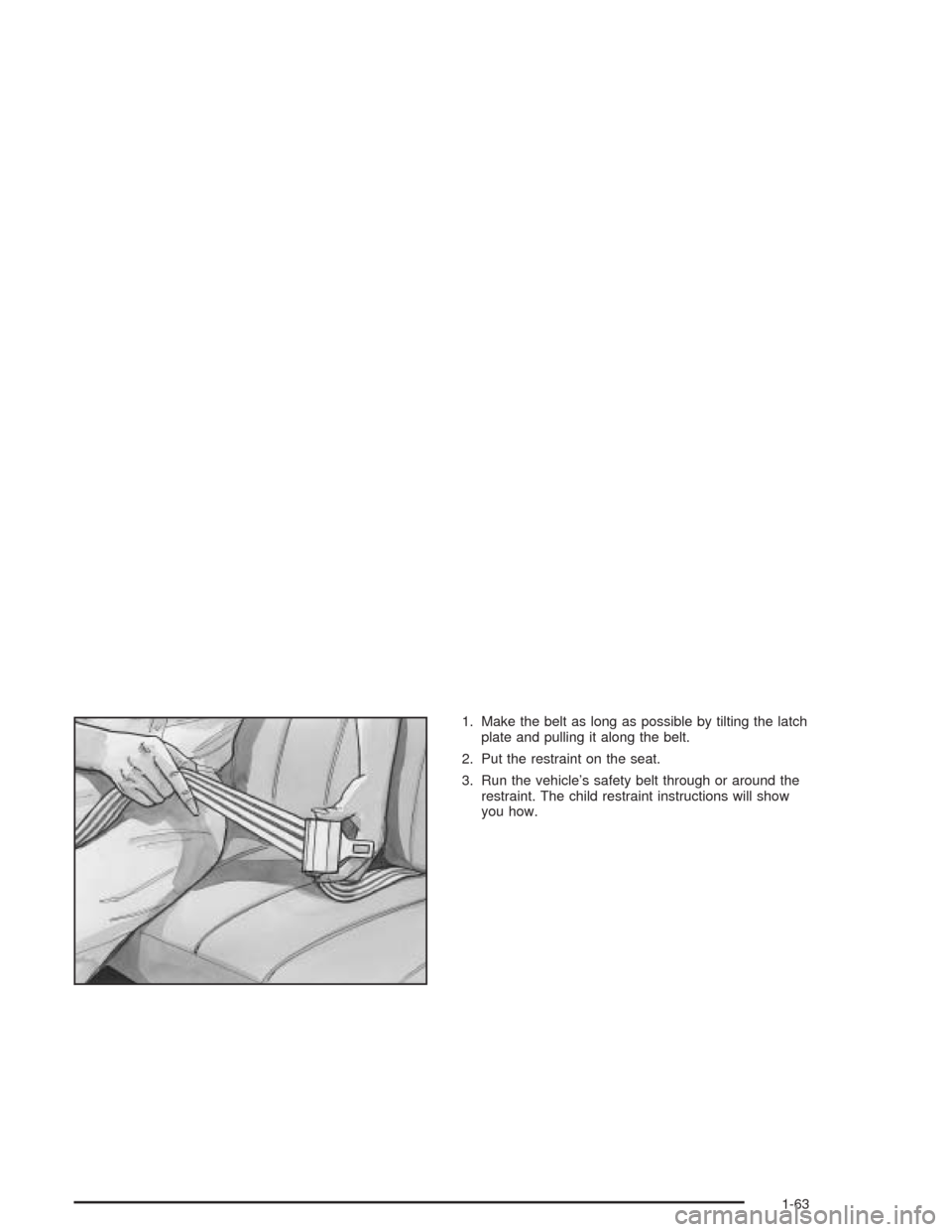
1. Make the belt as long as possible by tilting the latch
plate and pulling it along the belt.
2. Put the restraint on the seat.
3. Run the vehicle’s safety belt through or around the
restraint. The child restraint instructions will show
you how.
1-63
Page 70 of 406
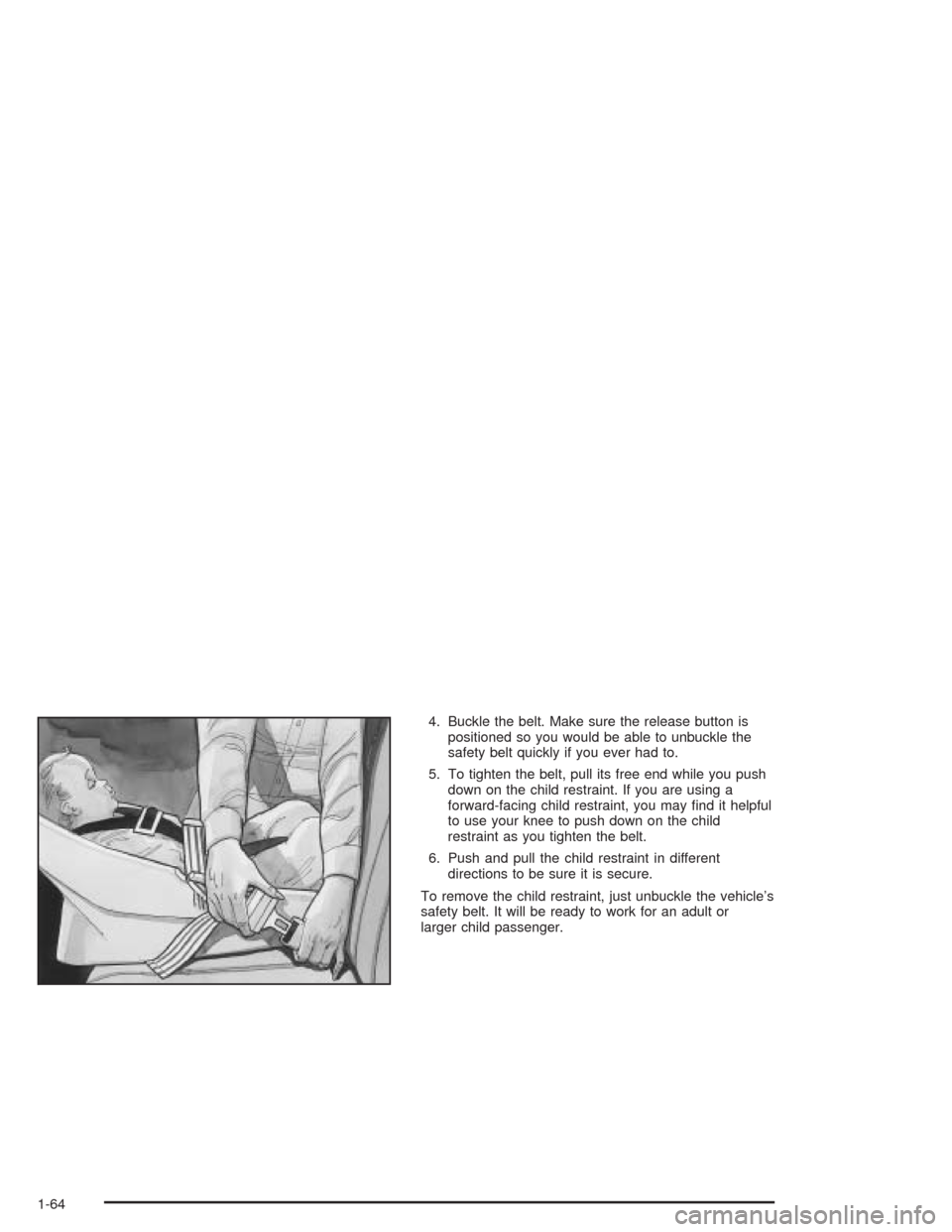
4. Buckle the belt. Make sure the release button is
positioned so you would be able to unbuckle the
safety belt quickly if you ever had to.
5. To tighten the belt, pull its free end while you push
down on the child restraint. If you are using a
forward-facing child restraint, you may �nd it helpful
to use your knee to push down on the child
restraint as you tighten the belt.
6. Push and pull the child restraint in different
directions to be sure it is secure.
To remove the child restraint, just unbuckle the vehicle’s
safety belt. It will be ready to work for an adult or
larger child passenger.
1-64